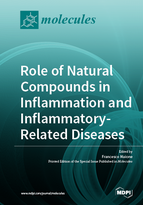Role of Natural Compounds in Inflammation and Inflammatory-Related Diseases
A special issue of Molecules (ISSN 1420-3049). This special issue belongs to the section "Natural Products Chemistry".
Deadline for manuscript submissions: closed (31 July 2019) | Viewed by 62168
Special Issue Editor
Interests: inflammation; immuno-pharmacology; pharmacology of natural compounds and nutraceuticals
Special Issues, Collections and Topics in MDPI journals
Special Issue Information
Dear Colleagues,
Inflammation is a complex biological response to injury as a result of different stimuli such as pathogens, damaged cells, or irritants. Inflammatory injuries induce the release of a variety of systemic mediators, cytokines and chemokines that orchestrate the cellular infiltration that consequentially bring about the resolution of inflammatory responses and the restoration of tissue integrity. However, persistent inflammatory stimuli or the disregulation of mechanisms of the resolution phase can lead to chronic inflammation and inflammatory-based diseases.
Nowadays, commercially approved anti-inflammatory drugs are represented by nonsteroidal anti-inflammatory drugs (NSAID), glucocorticoids (SAID), and in some cases immunosuppressant and/or biological drugs. These agents are effective for the relief of the main inflammatory symptoms. However, they induce severe side effects, and most of them are inadequate for chronic use.
Starting from these premises, the demand for new effective and safe anti-inflammatory drugs has furthered research into new therapeutic approaches. The recent and emerging scientific community slant is oriented towards natural products/compounds that could represent a treasure for the discovery of new active molecules and for the development of new drugs and potentially useful therapeutic agents in different inflammatory-related diseases.
We hope that this Special Issue will stimulate the interest of the scientific community involved in studying the effects of natural products/compounds on different fields of interests such as acute and chronic inflammation, inflammatory pain, inflammatory-related diseases (such as autoimmune disease) and other.
The papers published here will contribute to proposing new insights into the mechanisms of several conditions, as well as suggesting new diagnostic alternatives and therapeutic targets in widespread pathologies. The discovery of the new is, as always, anchored in recourse to the old.
Prof. Francesco Maione
Guest Editor
Manuscript Submission Information
Manuscripts should be submitted online at www.mdpi.com by registering and logging in to this website. Once you are registered, click here to go to the submission form. Manuscripts can be submitted until the deadline. All submissions that pass pre-check are peer-reviewed. Accepted papers will be published continuously in the journal (as soon as accepted) and will be listed together on the special issue website. Research articles, review articles as well as short communications are invited. For planned papers, a title and short abstract (about 100 words) can be sent to the Editorial Office for announcement on this website.
Submitted manuscripts should not have been published previously, nor be under consideration for publication elsewhere (except conference proceedings papers). All manuscripts are thoroughly refereed through a single-blind peer-review process. A guide for authors and other relevant information for submission of manuscripts is available on the Instructions for Authors page. Molecules is an international peer-reviewed open access semimonthly journal published by MDPI.
Please visit the Instructions for Authors page before submitting a manuscript. The Article Processing Charge (APC) for publication in this open access journal is 2700 CHF (Swiss Francs). Submitted papers should be well formatted and use good English. Authors may use MDPI's English editing service prior to publication or during author revisions.
Keywords
- Inflammation
- Inflammatory-based diseases
- Natural compounds
- Natural products
- Nutraceuticals







